During the Fall Semester, we will try to make a trip to
a couple of archives in the US to begin your research. For
example, in Chicago, the Newberry Library contains excellent
examples of historical books.
Some examples of topics of research
include:
Nineteenth Century Women Illustrators, including Kate Greenway
or Beatrix Potter.
Nineteenth Century Women Photographers, such as Lady Clemintina
Hawarden and Lady Filmer– both contemporaries of Julia
Margaret Cameron, in the 1860's.
Contemporary designers - if you have a particular contemporary
British designer you are interested in, you could make contact
with him or her before January and arrange to meet them
for an interview. . For example, Adrian Shaunessey of Intro
Design is often called upon to comment on design for the
British design press. (see image below).
GRAPHIC DESIGN
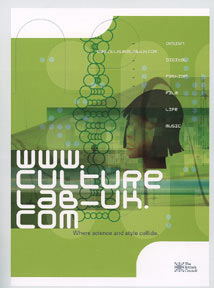 Some
of the material held on the Special Collections in the National
Art Library include:
Some
of the material held on the Special Collections in the National
Art Library include:
Comic Books and Graphic Novels
Fine and Noteworthy binding
Illuminated Manuscripts
Fine Printing
Artists' Manifestos
Artists' Books
Historical Posters
re available through the
V&A print room.
The Archives holds a large collection of street ephemera.
Periodically, they make a sweep of the steets and collect
an eclectic section of flyers, handbills, leaflets, promotions
for concerts, raves, massage services, fast food, in short,
every kind of popular culture artifact that can be found
printed or posted on the streets of london. Ironically ,
these archives are kept in one of the most secure off-site
locations, but can be visited by appointment. (The Design
Museum had a major retrospective of the work of Peter Saville,
who designed many rock album and CD covers.)
back
to top
PHOTOGRAPHY
If you have an interest in Photography,
the V&A print room has original photographs by 19th
and 20th century photographers, including P.H. Emerson,
Julia Margaret Cameron, Frederick Evans, Bill Brandt and
many more, including photographers like Lady Clementina
Hawarden, active in the 1860's and who was a contemporary
of Cameron.
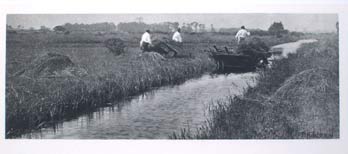
The sedge harvest; P.H. Emerson 1886
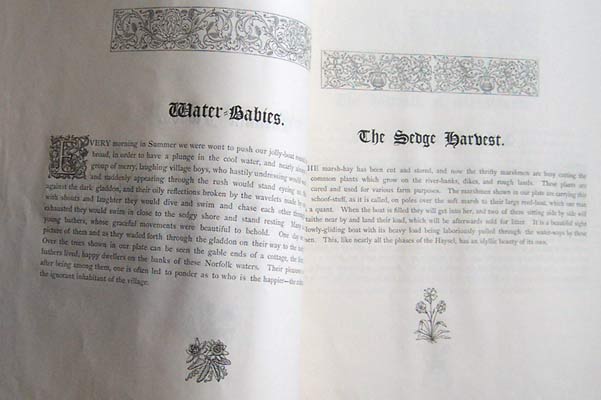 "Idylls
of the Norfolk Broads"
"Idylls
of the Norfolk Broads"
P.H. Emerson 1886
It is not every day that you have the priviledge
of handling original pieces of history. For me, personally,
it was wonderful to pull a chair up to a folio of prints
by 19th century photographer P. H. Emerson, and examine
the richly-toned gravure prints one at at time. Not only
were the prints magnificent to look at, but it was illuminating
also to see the cover of the folio, to read the text, and
to expereince it as it was intended, as a folio of images
and text. I was surprised at the blackletter type used to
print the title page for the folio, and in keeping weiht
Emerson's mission to have photography accepted as a fine
art, the cover of the folio was a gold-embossed engraving
based on one of timages in the folio, quaintly named "water
babies."
The Prints and books of photographic pioneer William
Henry Fox Talbot are available at the V&A, as are prints
by Cameron, Hill and Adamson, and many of Pictorialist Photograhers.
Early documentary photography was also beingn practiced
and published in London, such as Joseph Thomas's Street
Life on London, published in 1877.
back
to top
FURNITURE, INTERIOR and PRODUCT DESIGN
There are excellent opportunities to explore historic
styles of furnishing, from Elizabethan to Chippendale and
other 18th century styles to the Arts and Crafts Movement
started right in London by William Morris and his associates.
Modern and Contemporary design can be explored both in museum
and commercial settings.
Resources include:
The Geffrye Museum
which specializes in domestic interior from 1500-the present,
presenting domestic artifacts in a social context.
The William Morris
Gallery and Kelmscott House have archives on the arts and
crafts movement and people related to that period. , such
as the Pre-Raphaelites.
The Archives room
at the V&A Museum has extensive collections on fabric
design, furniture designs.
The Design Museum also
has rotating and permanent displays of product and furniture
design. 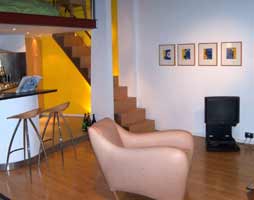 .
.
FASHION AND COSTUME DESIGN
For those interested in fashion, the V and A museum will
have a special exhibit of the fashion designers of Ossie
CLARK A wonderful exhibit of fashion and costume history
is on permanent display in the main V & A gallery.
BOOK ARTS
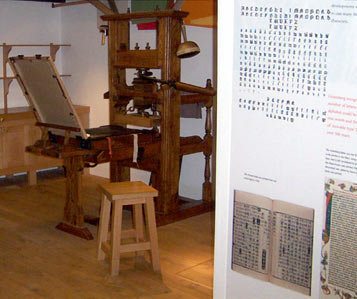
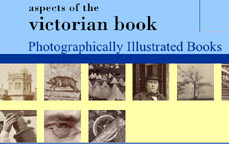
Artist handmade books are one of the fastest-growing areas
of fine art and an enduring interest of many graphic designers.
Creative and unique book-binding methods figure prominently
in design awards.The National Art Library and the British
Library have wonderful examples of both historic and contemporary
books collected specifically for their innovative folds,
binding, use of paper, type or other materials, or for the
creatie concept.
back to top
ILLUSTRATION
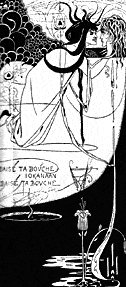 From
manuscript illumination to nineteenth century illustrators
like Beatrix Potter and Aubrey Beardslely, to underground
comics and graphic novels, illustration has gone through
many transformations. Start by reading a
From
manuscript illumination to nineteenth century illustrators
like Beatrix Potter and Aubrey Beardslely, to underground
comics and graphic novels, illustration has gone through
many transformations. Start by reading a
survey of types of illustration. From the survey class you
should know the difference between a woodcut, a line engraving
and a lithograph. Some possible topics to look at in this
area are Victorian children's book illustrations and children's
literature, (Kate Greenway, and others - By the way, there
is a great eclectic toy museum on London as well. )

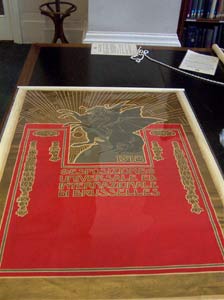
 Some
of the material held on the Special Collections in the National
Art Library include:
Some
of the material held on the Special Collections in the National
Art Library include:
 "Idylls
of the Norfolk Broads"
"Idylls
of the Norfolk Broads" .
.


 From
manuscript illumination to nineteenth century illustrators
like Beatrix Potter and Aubrey Beardslely, to underground
comics and graphic novels, illustration has gone through
many transformations. Start by reading a
From
manuscript illumination to nineteenth century illustrators
like Beatrix Potter and Aubrey Beardslely, to underground
comics and graphic novels, illustration has gone through
many transformations. Start by reading a